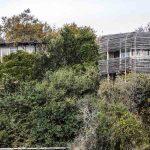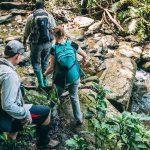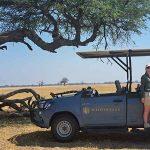In the green floodplain of the Luwego River, three crested francolins strutted to and fro. For a few moments, these birds became the most important things in my life and I watched their every move, breathless with tension.
Beyond the francolins lay the reason why I could hear my own heart pounding. The twitching ears and curved white horns of 30 buffaloes moved among the tall elephant grass. They grazed serenely, unaware of the human beings sneaking up on them.
But if those francolins saw us and sounded the alarm, the game would be up. How the half-ton beasts would then react to our presence was impossible to predict.
It seemed incredible that they had not spotted us. The buffaloes were so close that I could hear them tearing at the grass and pawing the ground.
My nose could even faintly detect their musty stench. If I could smell them, how could they not smell me?
The answer was that Anton Turner, my guide, had expertly kept us downwind of the herd. Minutes earlier, while still a safe distance away from the buffaloes, Anton had given a whispered briefing. “Buffalo have a reputation for being dangerous because of how they behave when they’re wounded. In this situation, 99 per cent of the time, they’ll just run if they see us. But if we are charged, you’re not going to be able to outrun them. Just lie down and keep as flat as you can. Then the buffalo might run around you. And make sure you stay behind my gun.”
Anton was carrying a Remington rifle loaded with six heavy-calibre rounds. It could take every one of those bullets to bring down a buffalo – and the herd was at least 30 strong.
Thankfully, there was no time to think about the manifold possibilities of disaster. Within moments, I was staring at the francolins and rapidly concluding that we were not going to fool them and the buffaloes at the same time.
Sure enough, the birds saw us. With high-pitched cries of alarm, they darted into the air; even the hiss of their beating wings seemed as loud as thunder. I braced for the reaction of the buffaloes, my heart beating faster still. Would they charge us or run away?
Astonishingly, they did neither. Their menacing horns and giant heads, with moist, flaring nostrils, carried on moving in the high grass, only 50 feet or so ahead. Nothing changed. The herd continued grazing sedately.
Anton led us closer still. Walking silently through long grass, I discovered, is impossible. You brush past green blades, stir up dead leaves and crunch on twigs. Each sound we made seemed cacophonous.
We were only about 30 feet away from the nearest buffalo and still they had not seen us. By now, I could make out the full outline of their jet-black bodies with flicking tails. I could see sweat glistening on muscles rippling beneath their hides.
Then, finally, the inevitable happened. A twig cracked and the herd saw us. The buffaloes raised their heads with sudden snorts and jerks of alarm and stared towards us. We stood stock still – and so did they.
This staring match lasted a matter of seconds, but seemed to crawl by like minutes. A few buffaloes edged curiously towards us, their horns held high. Would they charge?
Then, as if reacting to a silent signal, they broke and fled as one. The next few moments passed in a blur of movement and extreme, heart-pounding tension. The buffaloes stampeded away to my left, hooves pounding and nostrils flaring.
Then, as if from nowhere, another unmistakable animal appeared only 50 feet away. Without any warning, a fully grown lioness stood in front of me. She turned and leapt over a small stream, presenting an unforgettable mid-air silhouette of raw power, and then bounded away. In a split second, the lioness disappeared into the undergrowth, while the buffaloes fled across the floodplain.
My next thoughts had all the urgency that fear brings. We had not been the only ones stalking the buffaloes. Unseen by us, the lioness must have been hunting the herd.
If so, she would not have been alone. What about the rest of the pride? Anton soon found the reason for the lioness’s presence. A disembowelled warthog, with its purple intestines bulging onto the ground, lay exactly where the lioness had materialised. She had been guarding a kill. And she had, it seemed, been alone.
This episode taught me more about wildlife – and packed in far more emotional intensity – than any number of previous safaris. The unique exhilaration of tracking big game on foot while in your own expanse of African wilderness is the experience offered by the Selous Project in southern Tanzania.
Anton, a former British Army officer who co-founded the project, takes you on long treks across Selous Game Reserve, searching for elephants, buffaloes and lions. Instead of being driven around in a white Land Rover in the Serengeti or the Maasai Mara, where you are likely to share your pride of lions with a dozen other vehicles, you spend most of your time on foot, enjoying an intense, individual encounter with true wilderness.
Selous Game Reserve is little known outside Tanzania, yet it covers 21,000 square miles – an area bigger than Switzerland – making it the largest wildlife sanctuary in the world. The Selous Project’s concession embraces 300,000 acres of rugged bush along the Luwego and Lukula rivers. Until last year, this was a hunting area. All the neighbouring concessions are still used for this purpose.
But Anton and his partners in Great Plains Conservation, a company specialising in ecotourism, are trying a new model to replace hunting. The idea is for small groups of visitors to stalk big game on foot – and shoot the animals with cameras, not guns. Only eight guests can stay in the concession at any given time. So these safaris are high-value, low-volume and low-impact affairs. In this way, all the advantages of the hunting model are replicated while the crucial downside is removed: no animals are killed.
“We track the animals and get as close to them as we can. The only things we’re not doing are selecting a trophy and pulling the trigger,” explained Anton. These words carry particular authority because he was once a professional hunter. After leaving the Army as a captain, he led hunting expeditions across Tanzania.
But Anton, 37, has resolved never to hunt again. “I never want to shoot another lion,” he said. “I’ve been through the hunting business and, as a form of interaction with the environment, hunting is very pure. But I’m not sure that hunting has delivered the conservation gains it once did.”
The case for hunting rests on two pillars: money and conservation. With clients willing to pay huge sums to shoot big game, hunting provides a powerful incentive for conserving wildlife. But Anton believes this is changing. The rising cost of licences and fees has made Tanzania an expensive destination for those who shoot big game. “Hunting today is a model that is under pressure,” he said. “The government wants more money out of it, so it has raised block fees and trophy fees to the point where Tanzania is becoming uncompetitive compared to elsewhere in Africa.”
And the more the client pays, the more he demands. In theory, strict quotas limit the number of animals each hunting area is allowed to kill. In practice, these rules are impossible to enforce. The authorities will never know how many lions or elephants have been shot in a remote concession.
It is down to hunting companies to play by the rules. But their clients are often determined to shoot whatever species they want. Those from Russia and the Arab world have particularly bad reputations.
If that client wants a lion trophy, he will go home with one, no matter what. If the quota has been used up, this will not prevent an unscrupulous client from shooting the next male lion he sees. And if he comes across a more handsome specimen on a later outing, he will probably shoot that lion as well.
This behaviour destroys the conservation argument for hunting.
Instead, the future of conservation may lie in photographic safaris, where small groups of visitors spend most of their time on foot with minimal impact on the environment. “The acid test of all this is conservation. The big, long-term objective is to make sure this area is still wild in 50 years’ time,” said Anton.
His camp beside the Luwego has only four tents, equipped with twin beds and en suite bathrooms. These have elaborate bucket showers, topped up with hot water at your command. Meals are served in the main tent – which Anton, in true military fashion, called “the mess” – where golden lanterns light up rugs spread across the ground, in the style of an Arab sheikh’s retreat.
On most expeditions, Anton’s chief tracker, Abadiba Karibai, leads the way. If he ever leaves the wilderness, Abadiba could write a book on the secrets of a long and healthy life. At 72, he has been tracking big game since 1961 – and he looks like an exceptionally fit 55-year-old.
When we stalked the buffaloes, Abadiba was at the head of our column carrying a grey sock stuffed with ash. Every now and then he checked the direction of the wind by shaking the sock and releasing a puff of ash. In this way, he kept us downwind of the buffaloes’ nostrils.
Abadiba has survived being charged by lions no fewer than five times. Twice, he was armed only with a bow and arrow – and once he managed to fight off three lions with this flimsy weapon. “I shot one lion with an arrow. Then I had one lion here on my left and one on my right,” Abadiba told me. “They were too close to shoot. So I pushed an arrow into the mouth of one lion. After that, they both ran.”
Despite the reassurance offered by Abadiba and Anton, their expeditions are not for the faint-hearted. Approaching big game on foot will always be risky, and it demands a degree of physical robustness. If a river stands between you and the buffaloes, you simply wade through it, hoping that no crocodiles lurk nearby.
A typical stay in Anton’s Lukula concession will probably involve leaving the main camp for a three-day walk, staying in “fly camps” and marching for three hours at a time through rugged bush, under the intense rays of the African sun.
As Selous Game Reserve is so vast, the animals are widely dispersed. On foot, you cover less ground and, inevitably, see less wildlife, one of the disadvantages of this kind of safari. The lioness beside the herd of buffalo was the only big cat I saw in a week. In the Maasai Mara, you may share your lions with dozens of onlookers, but you will probably see them more.
And all kinds of logistical cock-ups are possible on three-day expeditions. On the first day of our walk the vehicle taking us to the starting point broke down. At nightfall, we had not reached the first fly camp. We could not contact the people at the camp because the radios had failed. A second vehicle that would have taken us to the camp also broke down.
So we ended up sleeping on a canvas tarpaulin spread on the bare earth. A large fire, carefully stoked all night, served as our protection from lions. This was a cock-up, pure and simple. But it also left us sleeping under the stars in the middle of a great wilderness.
As such, it was a perfect African experience.






